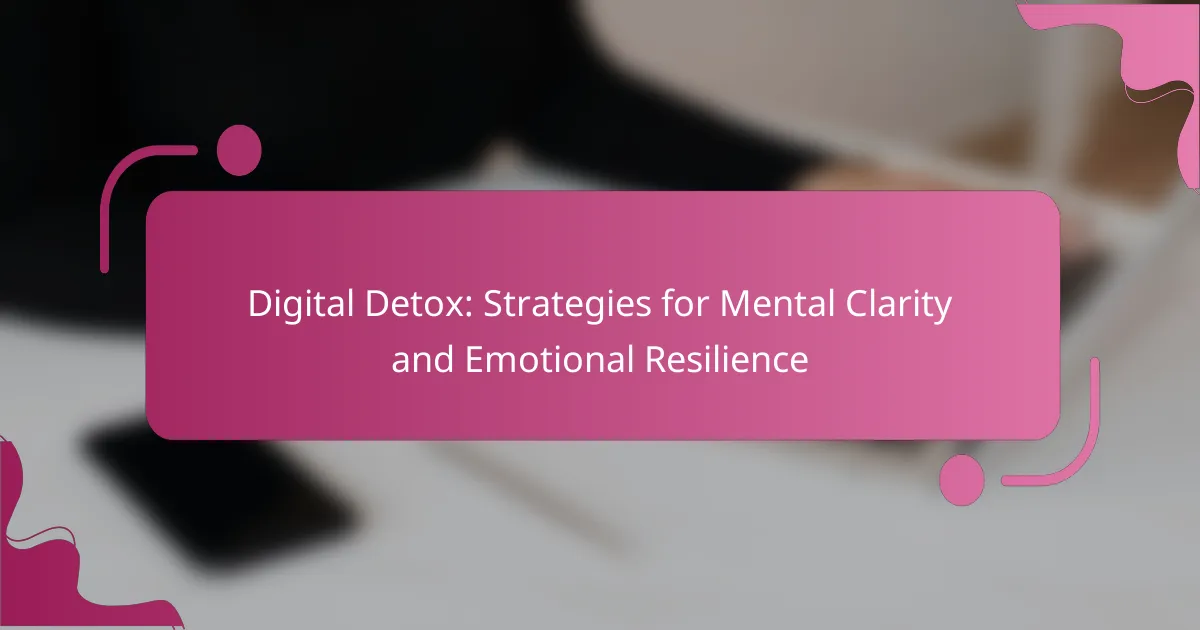A digital detox enhances mental clarity and emotional resilience by reducing information overload and stress. This article explores structured strategies for effective detox, including goal setting, creating distraction-free environments, and engaging in alternative activities. It also highlights the benefits of nature immersion and mindfulness practices in digital detox programs. Additionally, we will discuss common pitfalls to avoid for a successful experience.
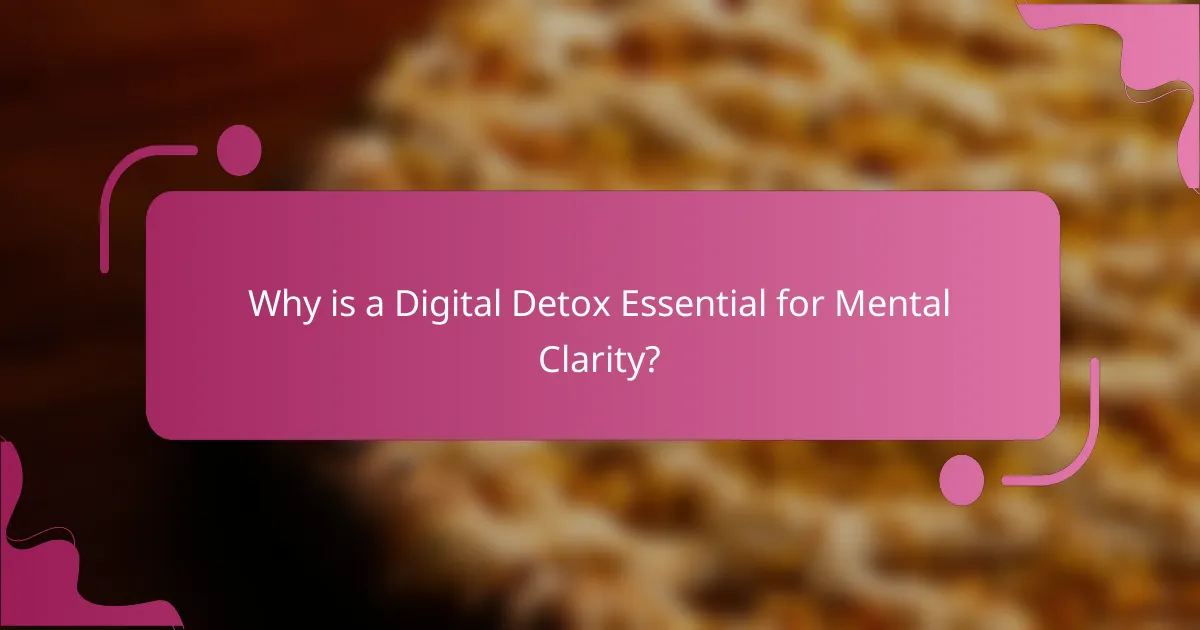
Why is a Digital Detox Essential for Mental Clarity?
A digital detox is essential for mental clarity as it reduces information overload and enhances focus. Constant exposure to screens can lead to cognitive fatigue, diminishing our ability to think clearly. By taking breaks from digital devices, individuals can improve their emotional resilience and regain control over their thoughts. Studies show that even short periods without technology can lead to increased creativity and better problem-solving skills. Prioritizing time away from screens fosters mindfulness and promotes a healthier mental state.
How Does Digital Overload Affect Mental Health?
Digital overload negatively impacts mental health by increasing stress and anxiety levels. Prolonged exposure to screens leads to cognitive fatigue and diminished emotional resilience. Strategies for a digital detox can enhance mental clarity and improve overall well-being. Regular breaks from technology, engaging in physical activities, and practicing mindfulness are effective methods to combat the adverse effects of digital overload.
What Are the Signs You Need a Digital Detox?
Signs you need a digital detox include feeling anxious, experiencing difficulty concentrating, and noticing decreased productivity. Other indicators are increased irritability, disrupted sleep patterns, and a constant urge to check devices. Recognizing these signs can help you reclaim mental clarity and emotional resilience.
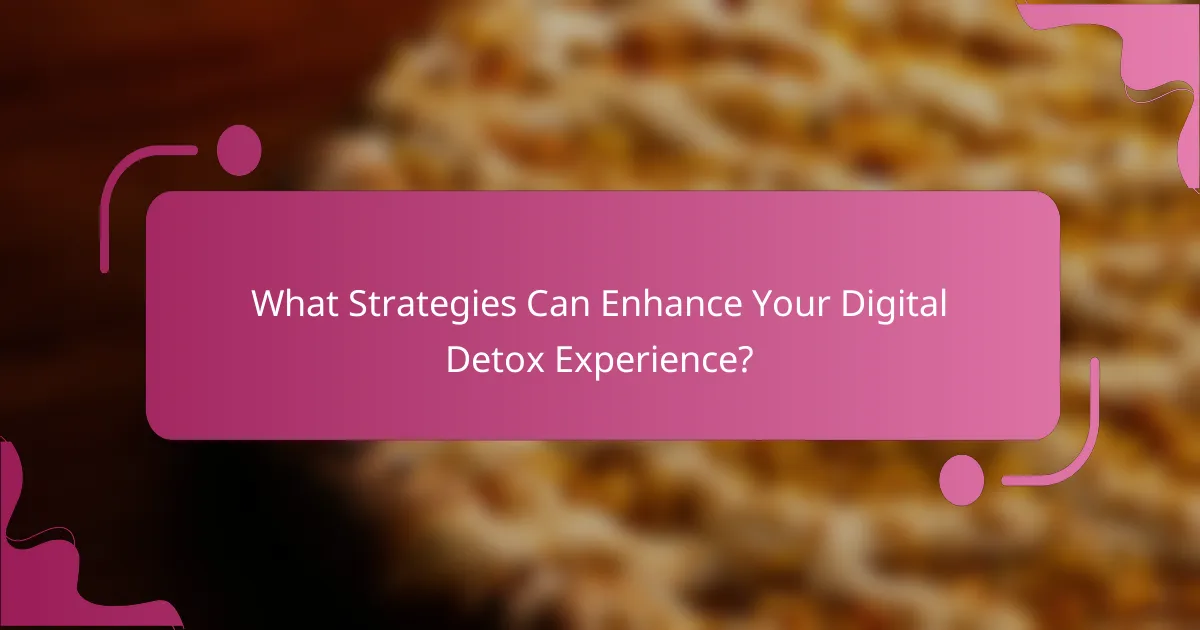
What Strategies Can Enhance Your Digital Detox Experience?
To enhance your digital detox experience, implement structured strategies that promote mental clarity and emotional resilience. Start by setting specific timeframes for your detox, allowing your mind to adjust.
1. Define clear goals for your detox, such as reducing screen time or focusing on mindfulness.
2. Create a distraction-free environment by removing devices from your immediate space.
3. Engage in alternative activities like reading, exercising, or meditating to fill the time previously spent online.
4. Establish a support system by sharing your goals with friends or family who can encourage your progress.
5. Reflect regularly on your feelings and experiences during the detox to understand its impact on your mental state.
These strategies can significantly improve your overall well-being and help you reconnect with your surroundings.
How to Create a Personalized Digital Detox Plan?
To create a personalized digital detox plan, first identify your specific digital habits and triggers. Next, set clear goals for your detox, such as reducing screen time or limiting social media use. Schedule regular breaks and engage in alternative activities like reading or exercising. Finally, track your progress and adjust your plan as needed to enhance mental clarity and emotional resilience.
Which Digital Detox Techniques Are Most Effective?
Digital detox techniques such as scheduled screen breaks, nature immersion, and mindfulness practices are highly effective. These strategies enhance mental clarity and emotional resilience by reducing digital distractions and promoting present-moment awareness.
Scheduled screen breaks involve setting specific times to unplug from devices, which can improve focus and reduce stress. Nature immersion encourages spending time outdoors, which has been shown to lower anxiety levels and boost mood. Mindfulness practices, like meditation or deep breathing, help cultivate awareness and emotional balance, further supporting a successful digital detox.
Incorporating these techniques into daily routines can lead to improved mental well-being and increased emotional resilience.
What Role Do Scheduled Breaks Play in Digital Detox?
Scheduled breaks are crucial in a digital detox as they enhance mental clarity and emotional resilience. Regular intervals away from screens reduce cognitive overload, allowing the mind to reset. Studies show that taking breaks improves focus and productivity, fostering a healthier relationship with technology. These pauses also promote mindfulness, enabling individuals to reconnect with their surroundings and emotions, thus supporting overall well-being.
How Can Mindfulness Practices Complement a Digital Detox?
Mindfulness practices enhance a digital detox by promoting mental clarity and emotional resilience. They help individuals reconnect with their thoughts and feelings, reducing anxiety often triggered by digital distractions. Mindfulness techniques, such as meditation and deep breathing, foster present-moment awareness, enabling a smoother transition during a digital detox. As a result, users can experience improved focus and a greater sense of well-being. Integrating mindfulness into a digital detox can significantly amplify its benefits, leading to lasting changes in mental health and emotional stability.
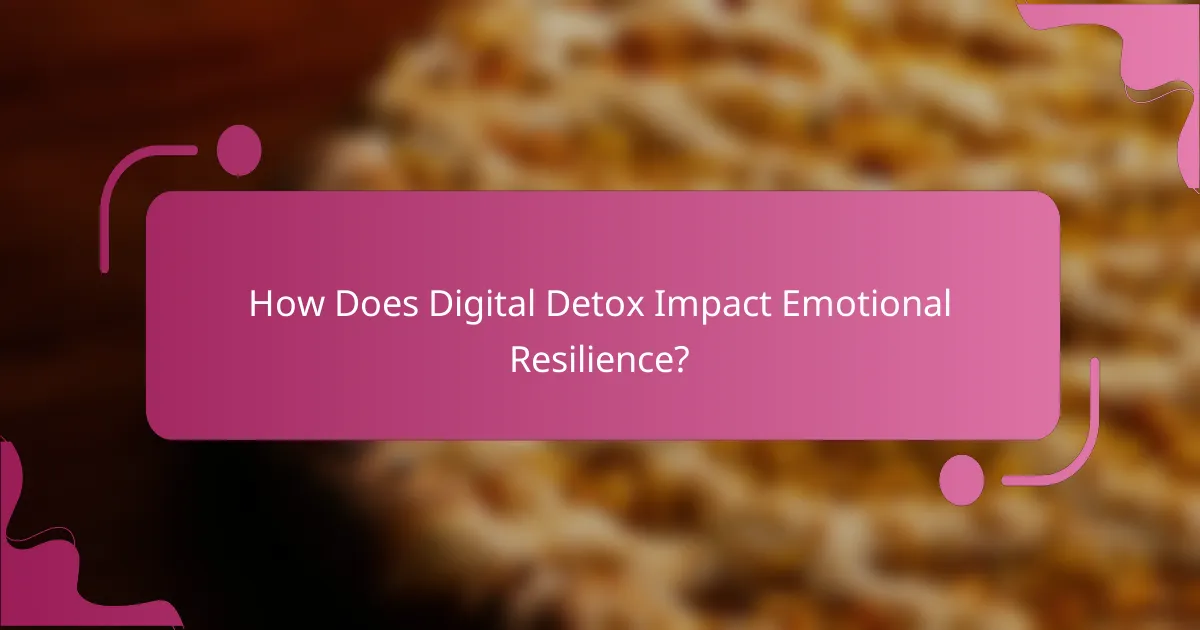
How Does Digital Detox Impact Emotional Resilience?
Digital detox significantly enhances emotional resilience by reducing stress and anxiety levels. This break from digital devices fosters mindfulness and self-awareness. Studies show that individuals who engage in regular digital detoxes report improved mood and better coping strategies in challenging situations. By disconnecting, people can reconnect with themselves and their surroundings, leading to stronger emotional well-being.
What Are the Psychological Benefits of Reducing Screen Time?
Reducing screen time offers significant psychological benefits, enhancing mental clarity and emotional resilience. It decreases anxiety levels, improves focus, and fosters better relationships by promoting real-life interactions.
Studies show that excessive screen time correlates with increased stress and decreased well-being. Engaging in a digital detox can lead to improved mood and cognitive function. As a result, individuals report feeling more present and connected to their surroundings.
By prioritizing offline activities, people can experience enhanced creativity and problem-solving abilities. This shift allows for deeper reflection and personal growth, which are crucial for emotional resilience.
In summary, reducing screen time can profoundly impact mental health, leading to a more balanced and fulfilling life.
Which Emotional Challenges Can a Digital Detox Help Overcome?
A digital detox can help overcome anxiety, stress, and feelings of isolation. Reducing screen time fosters emotional resilience, improves focus, and enhances social connections. Studies indicate that limiting digital consumption can lead to increased mindfulness and overall mental clarity. By disconnecting, individuals often experience a greater sense of well-being and emotional stability.
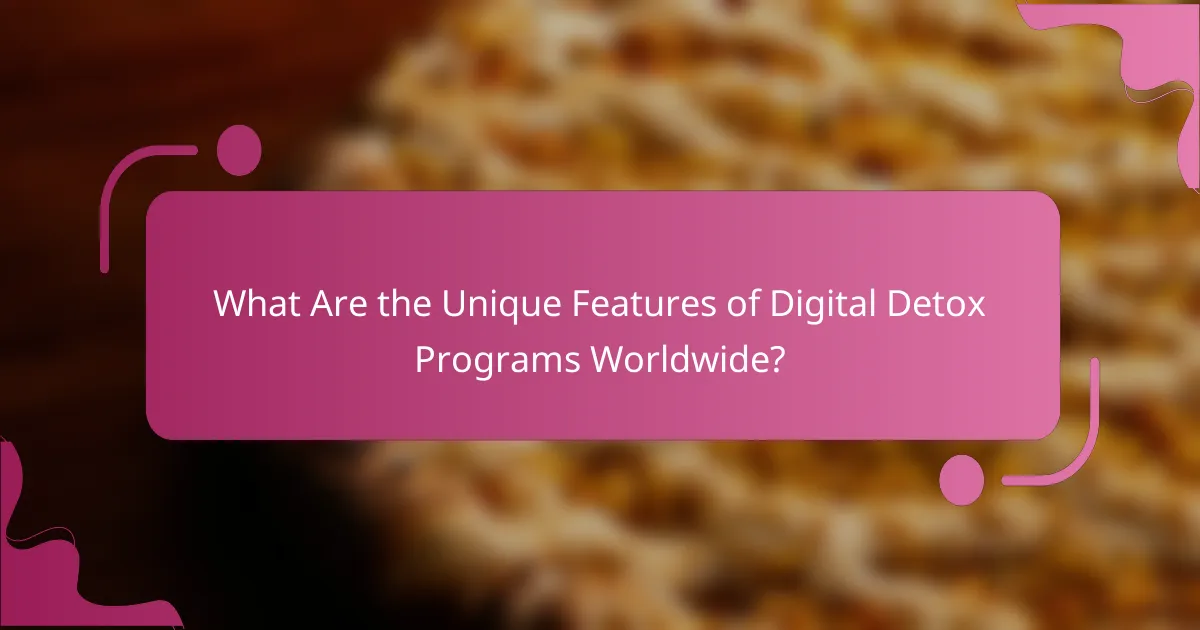
What Are the Unique Features of Digital Detox Programs Worldwide?
Digital detox programs worldwide feature unique approaches tailored to enhance mental clarity and emotional resilience. These programs often incorporate nature immersion, mindfulness practices, and technology-free retreats.
1. Nature immersion: Many programs emphasize outdoor activities, promoting psychological well-being through natural environments.
2. Mindfulness practices: Techniques such as meditation and yoga are commonly integrated, fostering emotional balance and reducing anxiety.
3. Technology-free retreats: Participants disconnect from digital devices, encouraging personal reflection and interpersonal connections.
4. Customized workshops: Programs often provide tailored sessions addressing individual challenges related to technology use.
5. Community support: Group activities and shared experiences enhance motivation and accountability among participants.
6. Varied durations: Programs range from weekend retreats to extended stays, allowing flexibility based on personal needs.
How Do Cultural Differences Influence Digital Detox Approaches?
Cultural differences significantly shape digital detox approaches by influencing attitudes toward technology use. In collectivist cultures, group harmony may drive individuals to disconnect together, fostering community support. Conversely, individualistic cultures may emphasize personal choice and autonomy in digital detox strategies. For example, cultures with strong spiritual practices might integrate mindfulness and meditation into detox routines. Additionally, varying work-life balance norms affect how people prioritize screen time reduction. Understanding these cultural nuances can enhance the effectiveness of digital detox methods globally.
What Are the Most Innovative Digital Detox Retreats Available?
Some of the most innovative digital detox retreats focus on immersive experiences that promote mental clarity and emotional resilience. These retreats often incorporate nature, mindfulness practices, and technology-free environments to foster deep relaxation and personal growth.
One standout option is the “Disconnect to Connect” retreat in Costa Rica, which combines yoga, meditation, and adventure activities like hiking. Participants engage in workshops that emphasize digital mindfulness and self-reflection.
Another notable retreat is “The Digital Detox Retreat” in California, offering a structured program that includes guided meditations, group discussions, and activities without screens. The focus is on building emotional resilience through community support and nature immersion.
Lastly, “Mindful Escape” in Bali integrates wellness practices with sustainable living, encouraging participants to reconnect with themselves and the environment. Attendees experience workshops on digital balance, fostering long-term strategies for maintaining mental clarity post-retreat.
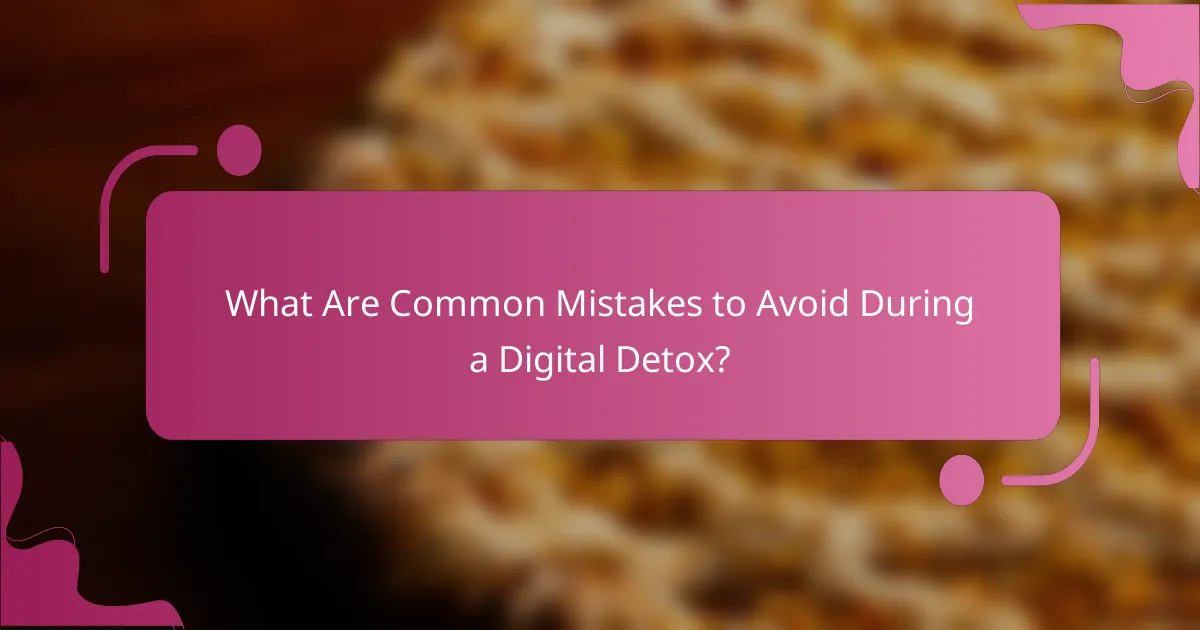
What Are Common Mistakes to Avoid During a Digital Detox?
To maximize the benefits of a digital detox, avoid common mistakes like setting unrealistic goals, not preparing for withdrawal symptoms, and failing to establish a support system. These errors can hinder your progress and reduce emotional resilience.
1. Setting unrealistic goals: Aim for achievable limits on device usage instead of complete abstinence.
2. Ignoring withdrawal symptoms: Anticipate feelings of anxiety or boredom and have strategies to cope.
3. Not creating a plan: Outline specific activities to engage in during the detox period.
4. Lacking accountability: Share your goals with friends or family for support and encouragement.
5. Focusing solely on technology: Remember to address underlying issues like stress or anxiety that may drive excessive device use.
How Can You Stay Committed to Your Digital Detox Goals?
To stay committed to your digital detox goals, establish clear boundaries and create a supportive environment. Set specific times for device use, engage in offline activities, and track your progress. Share your goals with friends or family for accountability. Regularly reflect on your experiences to reinforce your commitment.
What Resources Are Available to Support Your Digital Detox Journey?
Numerous resources can support your digital detox journey. Online communities provide encouragement and shared experiences. Apps designed for mindfulness can help track screen time and promote healthier habits. Books on digital minimalism offer strategies and insights. Workshops and retreats focus on disconnecting from technology. Support groups facilitate discussions on challenges and successes. Professional counseling can address underlying issues related to technology use.
What Expert Tips Can Help You Maximize Your Digital Detox Benefits?
To maximize your digital detox benefits, establish clear boundaries for device usage. Prioritize engaging in offline activities that promote mindfulness and social connection. Create a structured schedule that allocates specific times for digital engagement and breaks. Incorporate nature walks or meditation practices to enhance mental clarity and emotional resilience.
